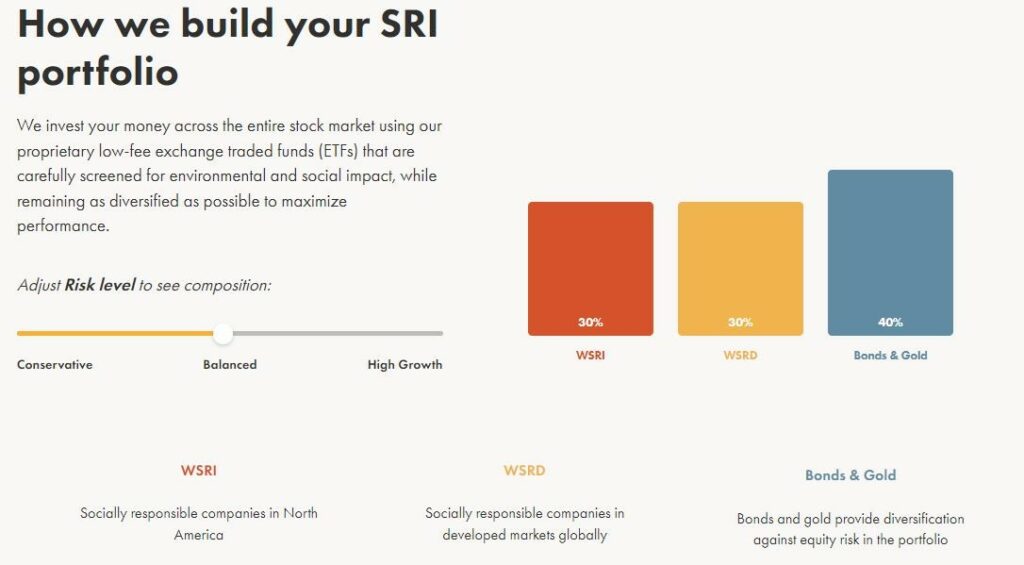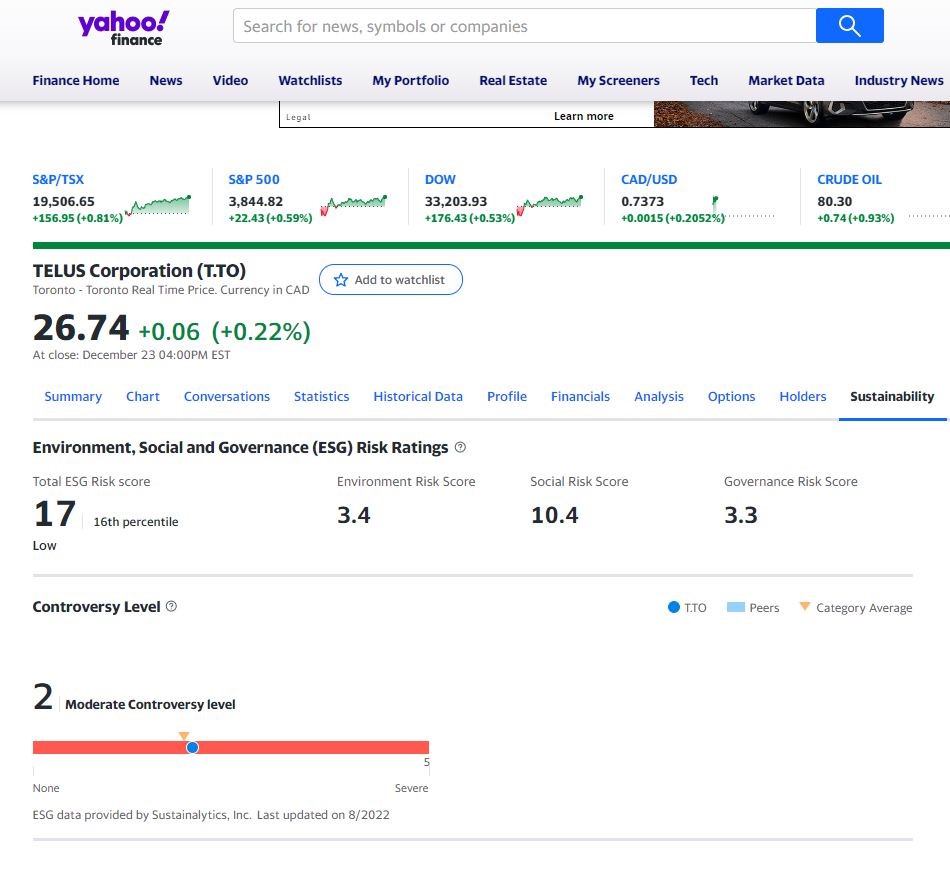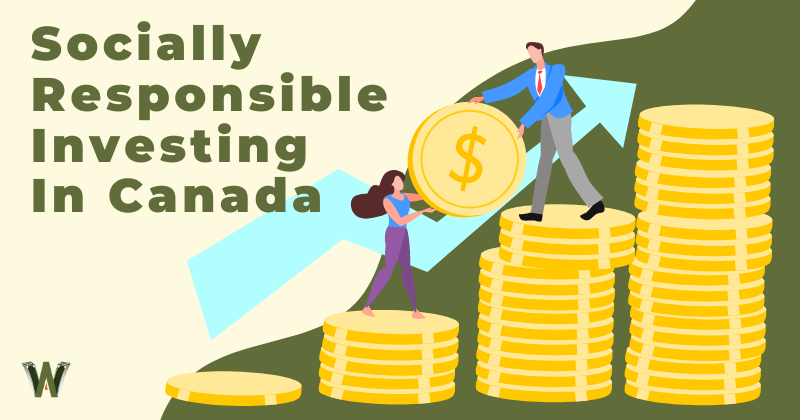Are you looking to invest responsibly as a Canadian but have no idea how to get started?
Socially responsible investing, or SRI, is a trend that is quickly being picked up by large institutions around the world and is also transitioning to everyday investors.
A study by Standard Chartered estimates that as much as $8.2 trillion in retail assets could be added to sustainable investments by 2030.
The great news is that many asset managers in Canada have already taken steps to offer many excellent SRI solutions to investors.
I will cover socially responsible investing in Canada below and go over five of the best ways of investing in SRI.
Understanding Socially Responsible Investing
Before investing responsibly, it is important to understand exactly what socially responsible investing is and how it is incorporated into the investment process. Socially responsible investing can be broken down into three main components:
- Environment
- Social
- Governance
These three main components are frequently quoted as ESG, leading to the label ESG investing (another way to refer to socially responsible investing). These three main areas are what analysts typically look at when determining how socially responsible an investment really is.
The environmental aspect is typically the easiest one to understand. It involves looking at how a company or business treats its resources, waste, and the planet in general. Analysts may look at how efficiently resources are being used, carbon dioxide emissions, waste generation, water usage, and more.
The social aspect refers to the company’s inner workings, particularly regarding its labour force and supply chain. This area focuses on things such as discrimination among employees, working conditions, and standards such as wages when it comes to a company’s supply chain.
Lastly, the governance aspect focuses on elements such as executive compensation, corruption or bribery, and shareholder treatment.
Socially responsible investing allows analysts to evaluate a company on metrics that typically fall outside of financial reports and more commonly analyzed performance metrics. Assessing ESG risks can be an excellent way to mitigate risks when considering an investment in a business or a company.
Socially Responsible Investing in Canada: Five Ways to Invest in SRI
There are several different ways to approach investing responsibly in Canada depending on how hands-on you would like to be with your investments.
1. Exchange-Traded Funds (ETFs)

- Risk: medium – high
- Minimum investment amount: low
- Depth of ESG analysis: low – medium
- Fees: low
- Liquidity: high
Exchange-traded funds that have an ESG or responsible investing focus are one of the best ways to invest responsibly in Canada.
More and more investment managers in Canada have decided to launch socially responsible investing products (like ETFs) given the large increase in demand from investors. ESG ETFs can roughly be broken down into three main groups when thinking about socially responsible investing:
- Exclusion-based ESG ETFs
- Inclusion-based ESG ETFs
- Thematic ESG ETFs
Exclusion-based ESG ETFs typically do the least-intensive amount of ESG research. These passive ETFs tend to exclude companies that fall within specific sectors, such as weapons, fossil fuels, or adult content.
Once these sectors are excluded, the ETF continues investing according to a specific index.
Inclusion-based ESG ETFs focus exclusively on building a portfolio of ESG investments based on certain criteria. The level of ESG research for inclusion strategies is typically more comprehensive than for exclusion strategies. These funds typically invest entirely in assets that qualify as ESG investments.
Thematic ESG ETFs tend to invest according to a specific theme and are usually not as broad in their mandate. An example of a thematic ESG ETF would be an ETF that only invests in clean energy companies. These ETFs, while typically less diversified, provide a deep level of ESG research.
Exchange-traded funds typically come with at least a medium risk rating (for stock ETFs) and have a low investment minimum relative to other investments. ETFs typically come with low fees (especially if passively managed) and are usually very liquid, especially if the fund is large and actively traded.
Keep in mind that the more complex the level of ESG research is for a fund, the more expensive the mandate will be to access (with regard to its management expense ratio).
A key benefit of investing responsibly through an ETF is that it allows you to diversify your assets by using a pooled investment. If you are looking to invest smaller amounts of money into ESG assets, it can be difficult to properly diversify a portfolio without a pooled investment like an ETF.
Be sure to read my guide on the best ESG ETFs in Canada.
2. Mutual Funds

- Risk: medium – high
- Minimum investment amount: low
- Depth of ESG analysis: medium – high
- Fees: high
- Liquidity: medium – high
Mutual funds were previously one of the most popular pooled investment vehicles in Canada. Since the recent gain in popularity for ETFs (which are a more efficient structure and typically come with lower fees), mutual funds have taken a bit of a back seat when it comes to investing.
With that said, mutual funds can be a good way to invest responsibly since most mutual funds are actively managed. Active management is usually a requirement for very deep ESG investing, especially if you are considering thematic strategies.
Similar to ETFs, ESG mutual funds are generally exclusion-based, inclusion-based, or thematic when it comes to their overall strategy.
Unlike ETFs, mutual funds do not trade like stocks on an exchange. Mutual funds trades are processed after market close, meaning that you do not have the ability to buy and sell mutual funds throughout the day.
Mutual funds can invest in a wide range of assets, just like ETFs. Typically, stock mutual funds will have at least a medium risk rating. Mutual funds require a small minimum investment and typically charge higher fees relative to most ETFs.
If you are looking to learn more about the differences between mutual funds and ETFs, take a look at my ETFs vs mutual funds in Canada article.
3. Robo-Advisors

- Risk: low – high
- Minimum investment amount: low
- Depth of ESG analysis: medium
- Fees: low
- Liquidity: medium
Robo-advisors are platforms set up by some Canadian brokers that are designed to replace working with a human investment or financial advisor. Investment or financial advisors typically charge high fees for working with them, which can greatly impact your returns over the long term.
In some cases, robo-advisory platforms will offer ESG portfolios, allowing you to invest responsibly through an automated service. These platforms generally start by presenting you with one or more questionnaires that are designed to determine your financial characteristics, constraints, and goals.
In most cases, robo-advisors will be investing mostly in multiple underlying ETFs which will be screened for ESG characteristics.
Two excellent options when it comes to robo-advisors are Wealthsimple Invest (offered by Wealthsimple) and Questwealth (offered by Questrade).
Both Questwealth and Wealthsimple Invest offer ESG portfolios of varying risk based on your characteristics as an investor.
Questwealth

Wealthsimple Invest

Robo-advisors are accessible to almost everyone since they are offered with a very low (if any) investment minimum.
Although not as liquid as an individual stock or ETF, portfolios set up by robo-advisors can be converted to cash fairly quickly.
Make sure to read my guide on the best robo-advisors in Canada if you are looking for additional options.
4. Stocks

- Risk: medium – high
- Minimum investment amount: low
- Depth of ESG analysis: high
- Fees: low
- Liquidity: low – high
If you have a lot of time on your hands, another way to invest in a socially responsible manner is to do your own research on individual stocks. This is one of the best ways to have total control over exactly what kind of investments are in your portfolio.
One of the simplest ways to invest in ESG stocks is to avoid industries that go against the concepts of responsible investing. These industries or sectors can include:
- Tobacco
- Oil and gas
- Adult content
- Gambling
While this is not a very deep level of due diligence, it obviously avoids companies in some of these controversial sectors.
If you are looking to take your ESG stock investing to the next level, you can take advantage of public ESG ratings that are available on some websites.
A lot of individual stocks, especially if searched for through Yahoo Finance, will have some information about the stock’s ESG ranking (versus peers) as well as how sustainable the company is.
In the below example using Telus, research is provided by Sustainalytics and includes:
- A total ESG risk score
- Environmental risk score
- Social risk score
- Governance risk score
- Controversy level

You can use this free information to help your stock-picking decision-making when putting together an ESG stock portfolio.
Keep in mind that stocks typically come without any management fees (you will only be paying trading commissions, if even that). If you are looking to trade stocks without paying commissions, a good platform to use is Wealthsimple Trade.
5. Investment Advisor

- Risk: low – high
- Minimum investment amount: high
- Depth of ESG analysis: low – high
- Fees: high
- Liquidity: low – high
Working with an investment advisor, although not something that I recommend is another way to invest responsibly in Canada.
Investment advisors are very diverse in their backgrounds and skill sets. Some advisors exist that exclusively build an investment practice around socially responsible investing. If you are looking for a good level of ESG analysis, make sure to partner with an advisor that has ESG investing as a main focus.
Most investment advisors that do not focus on ESG will likely be doing a similar level of ESG due diligence that you could do with free resources online. Advisors are able to put together portfolios that can be low-risk or high-risk, depending on your specific situation and circumstances.
Working with an investment advisor typically requires a very large portfolio. Most investment advisors, due to how their advisory fees are charged, will implement a minimum portfolio amount that is usually at least $100,000.
Investment advisors also typically charge very high fees relative to the other ESG investing options on my list.
Unless you are considering working with an ESG-dedicated advisor that also provides additional services such as financial planning, it’s likely better to consider other alternatives to socially responsible investing in Canada.
Frequently Asked Questions
Socially Responsible Investing through Wealthsimple?
If you want to invest responsibly through Wealthsimple, it is an option through the Wealthsimple Invest robo-advisory service.
The responsible investing portfolio offered through Wealthsimple Invest primarily focuses on three elements:
- The WSRI ETF
- The WSRD ETF
- Bonds and gold
Based on your specific characteristics as an investor, Wealthsimple Invest will create a portfolio with a specific allocation percentage for each.
Be sure to take advantage of $25 for free when opening your first Wealthsimple Invest account.
Responsible Investment Association?
The Responsible Investment Association (or RIA) is a Canadian company focused on the education of investors and asset managers around ESG investing and responsible investing.
The company offers various levels of training, as well as several responsible investing certificates. The RIA website can also be used to guide your ESG research by filtering Canadian investment products for ESG across:
- Mutual funds
- ETFs
- GICs
- Separately managed accounts
- Segregated funds
The Responsible Investment Association offers an abundance of information and research on ESG that can help you to learn more about investing responsibly in Canada.
Conclusion

If you are looking to invest responsibly in Canada, there are many options available to you that vary in:
- Cost
- The complexity of ESG research
- Risk
- Investment minimum
If you are looking to have the most control over what ESG assets are in your portfolio, consider researching individual stocks (if they fit your risk tolerance) using the abundant free information that is available online today.
Other excellent alternatives to picking stocks include investing in ESG ETFs or taking advantage of ESG portfolios offered by robo-advisors in Canada.
If you are looking for stock ideas in this space, make sure to read my article on the best ESG stocks in Canada.

